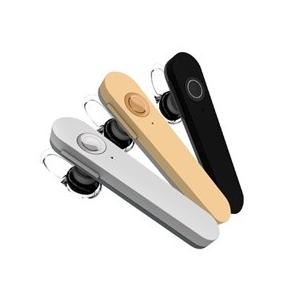

Add to Cart
Bluetooth headset-NW-C500i specification
Bluetooth Headset V4.1+EDR, HFP and A2DP profile, up to 100 hours standby time
| Distance Range | 10 M |
| Bluetooth Protocol | V4.1 + EDR |
| Bluetooth Profile | HSP + A2DP |
| Microphone | Build in |
| Battery Capacity | 55 mAh |
| Low battery warning | Yes |
| Audio freq. range | 20-20Khz |
| Charging Time | 1-2 Hours |
| Standby Time | up to 100 Hours |
| Phone call time | 3 Hours |
| Music playback | 3 Hours |
| Connector | Micro-USB |
A typical Bluetooth headset.
Bluetooth technology is widely used for short-range voice
transmission. While it can be and is used for data transmission,
the short range (due to using low power to reduce battery drain) is
a limiting factor. A very common application is a hands-free
Bluetooth earpiece for a phone which may be in a user's pocket.
A stereo Bluetooth headset.
There are two types of Bluetooth headsets. Headsets using Bluetooth
v1.0 or v1.1 generally consist of a single monaural earpiece, which
can only access Bluetooth's headset/handsfree profile. Depending on
the phone's operating system, this type of headset will either play
music at a very low quality (suitable for voice), or will be unable
to play music at all. Headsets with the A2DP profile can play
stereo music with acceptable quality. Some A2DP-equipped headsets
automatically de-activate the microphone function while playing
music; if these headsets are paired to a computer via Bluetooth
connection, the headset may disable either the stereo or the
microphone function.
Advanced Audio Distribution Profile (A2DP)
This profile defines how multimedia audio can be streamed from one
device to another over a Bluetooth connection (it is also called
Bluetooth Audio Streaming). For example, music can be streamed from
a mobile phone, to a wireless headset, hearing aid/cochlear implant
streamer, car audio, or from a laptop/desktop to a wireless
headset; also, voice can be streamed from a microphone device to a
recorder on a PC. The Audio/Video Remote Control Profile (AVRCP) is
often used in conjunction with A2DP for remote control on devices
such as headphones, car audio systems, or stand-alone speaker
units. These systems often also implement Headset (HSP) or
Hands-Free (HFP) profiles for telephone calls, which may be used
separately.
Each A2DP service, of possibly many, is designed to uni-directionally transfer an audio stream in up to 2 channel stereo, either to or from the Bluetooth host. This profile relies on AVDTP and GAVDP. It includes mandatory support for the low-complexity SBC codec (not to be confused with Bluetooth's voice-signal codecs such as CVSDM), and supports optionally MPEG-1 Part 3/MPEG-2 Part 3 (MP2 and MP3), MPEG-2 Part 7/MPEG-4 Part 3 (AAC and HE-AAC), and ATRAC, and is extensible to support manufacturer-defined codecs, such as aptX.
Some Bluetooth stacks enforce the SCMS-T digital rights management (DRM) scheme. In these cases, it is impossible to connect certain A2DP headphones for high quality audio.
Headset Profile (HSP)
This is the most commonly used profile, providing support for the
popular Bluetooth headsets to be used with mobile phones. It relies
on SCO for audio encoded in 64 kbit/s CVSD or PCM and a subset of
AT commands from GSM 07.07 for minimal controls including the
ability to ring, answer a call, hang up and adjust the volume.
[From Wiki]
